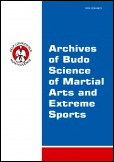2020, Volume 16, Issue 1
Anticipated, simultaneous and posterior counter-attack efficiency in Ultimate Full Contact
Fernando Loio Pinto1, Henrique P. Neiva1, Célia Nunes1, Luís Branquinho1, Ricardo Ferraz1
1Sports Sciences, University of Beira Interior, Covilhã, Portugal, Portugal
Author for correspondence: Ricardo Ferraz; Sports Sciences, University of Beira Interior, Covilhã, Portugal, Portugal; email: ricardompferraz@gmail.com
Full text
Abstract
Background & Study Aim: Ultimate Full Contact is a hybrid combat sport, where the counter-attack technique takes on special importance. However, to the best of our knowledge, no study has analysed the dynamics of anticipated, simultaneous and subsequent counter-attacks as a distinct technical-tactical efficiency for the fighters' performance. This study aims identifies and characterizes, according to the winning and losing athletes, the counter-attack dynamics (i.e. anticipated, simultaneous and posterior) according to the opponents’ attacks, with the purpose of identifying the most efficient and distinct counter-attack forms of the winners.
Materials & Methods: One hundred and seventy fights were observed, integrating (n = 340) senior male athletes representing 38 countries, who participated in the WUFC World Championships; all technical-tactical counter-attacks made and effective, by winners and losers, were registered and analysed through Spearman’s bivariate correlation, the Kalina method of measuring the dynamics of the fight (counterattacks efficiency) and Mann-Whitney U.
Results: The results indicate that winners had significant advantage in all counteroffensive skills regarding their temporal responses, with the number of counter-attacks made and their efficiency both decreasing: anticipated, simultaneous and posterior. The counter-attack made by the losers was in the same order, but its efficiency was in opposite order with significant difference, except at posterior counter-attack. The anticipated counter-attack showed 100% efficiency.
Conclusions: This study showed that winners counter-attacked more and more effectively, therefore showed greater efficiency. Anticipated counter-attack and simultaneous counter-attack proved to be the temporal responses that most contributed to winning a fight. It is important to develop prior defensive actions, which create a favourable fight distance and body stance for these counter-attacks, as well as developing related capacities (e.g. perception, anticipation, opportunity, timing, strategies).
Key words: skills, opportunity, technical-tactical, ground fighting, dynamics of the fight, combat sports, anticipation, stand-up fighting, timing





